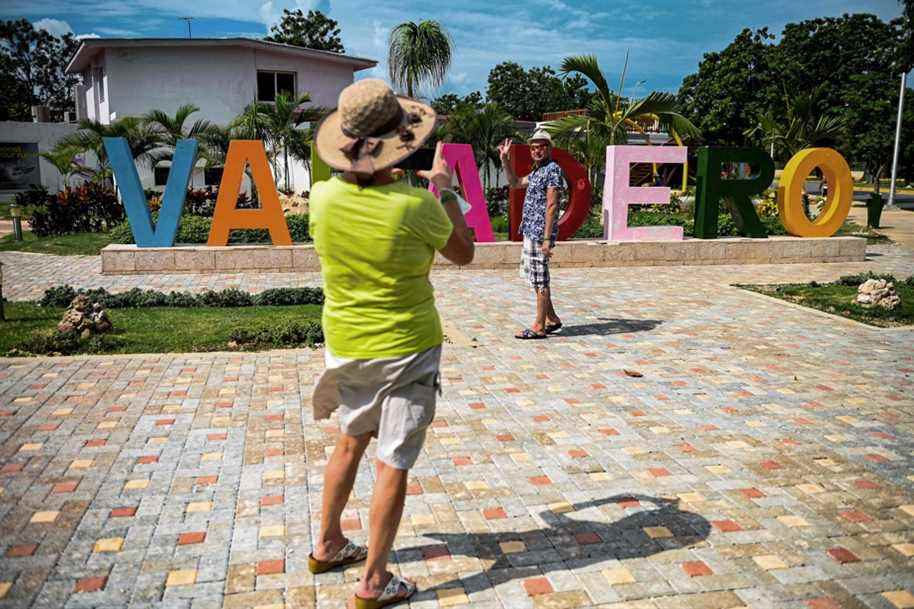(Havana) “It’s a relief,” says Melany Mayorga, a 16-year-old high school student, as the number of COVID-19 contagions has fallen in Cuba in recent weeks, which will allow it to open its doors to tourists on November 15.
Dressed in a beautiful red dress, the young girl will join her friends on the Malecon, the famous coastal boulevard of Havana which has come back to life since the lifting of the restriction measures and the curfew.
“It’s very hard to be separated from your friends […], it’s only now that we find ourselves, because the situation has improved, ”she said.
Taking a picture of herself with her comrades, Melany adds: “we have been in confinement for too long, that is understandable, because the number of cases was super high, but now that it has decreased, we can resume our activities”.
On November 15, Cuba will complete its return to normalcy, with the return to school of more than a million students and the reopening to international tourism, limited until then by the sharp reduction in flights and the closure of hotels. and restaurants across much of the island.
The objective is to revive the economy, deprived of foreign currency from tourism for long months, which has exacerbated the shortages of food and medicines.
In the first half of the year, the country received only 21.8% of visitors from the same period of 2020, 1.2 million people. For 2022 the government expects two million, half of what it hosted each year before the pandemic.
64.9% of vaccinated

PHOTO ALEXANDRE MENEGHINI, REUTERS ARCHIVES
The hotels and restaurants that have reopened hope to attract some of the 100,000 tourists expected by the end of December, traditionally the high season in Cuba.
“We are moving towards a controlled and phased reopening, with the guarantee that by November 15, at least 90% of the population will be vaccinated”, recently assured the Minister of Tourism Juan Carlos Garcia.
Currently, 7.3 million Cubans are immunized with locally developed vaccines (and awaiting WHO approval), or 64.9% of the population.
The island, which hopes to have vaccinated everyone at the end of 2021, is barely recovering from a violent new wave of the epidemic due to the Delta variant which rocked its health system from July, national pride.
On September 20, she still announced 8,544 new daily cases. As of Monday, only 633, out of a population of 11.2 million.
Amilcar Pérez-Riverol, Cuban researcher from the Fapesp Foundation, at the State University of Sao Paulo (Brazil), sees there a double effect: vaccination, but also acquired collective immunity.
“The vaccination in Cuba took place at the same time as one of the world’s worst waves of contagion per 100,000 inhabitants,” he explains on Twitter. Now “this drop is the result of vaccination and the costly effect of immunity by contagion, as has been demonstrated in all the countries that suffered from a wave caused by Delta”.
In the pedestrianized Obispo street in Havana, Zayda Santana, 52, says “enjoying, it’s so beautiful”. Employed with elderly people, it had been “two years” that she had not been in this shopping aisle.
“Nightmare not over”

PHOTO YAMIL LAGE, AGENCE FRANCE-PRESSE ARCHIVES
The famous “Almendrones”, those old colored American sedans, are also waiting for the starting signal.
Not far from there, hotels and restaurants have reopened their doors, hoping to attract some of the 100,000 tourists expected by the end of December, traditionally the high season in Cuba.
To facilitate matters, the government abolishes, from November 7, the obligation of quarantine on arrival, then on 15, the PCR test carried out at the airport. Tourists will only need to show proof of vaccination or a negative PCR test within 72 hours.
The famous “almendrones”, those old colored American sedans, are also waiting for the starting signal.
Driving tourists to these antiques, “it’s better than working for the state, you always earn a little more,” says Oscar Ulecia, a 33-year-old driver who wears dark glasses and a cowboy hat. For two years, for lack of clients, he had had to return to his old job: accountant.
“I’m super happy, we can all meet again,” rejoices Ronald Ibáñez, a 25-year-old dancer who trains for breakdance in the street.
But he remains cautious: “The nightmare is not completely over, we just have to try to live differently, with a new normal”.
